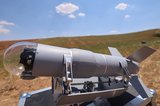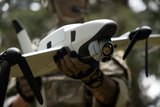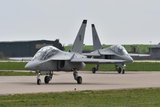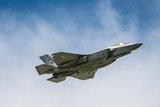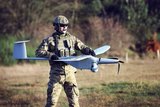General Atomics demonstrates C2 for MUM-T
Ruggedised tactical control tablet, integrated with Autonodyne’s RCU-1000 advanced HMI. (Photo: General Atomics)
General Atomics Aeronautical Systems (GA-ASI) has demonstrated manned-unmanned teaming (MUM-T) with its MQ-20 Avenger.
The company-owned UAV was paired with a modified King Air 200 (as a surrogate fighter aircraft) in a 2h flight on 25 August.
‘The flight demonstrated autonomous collaboration using command and control (C2) of the Avenger from a ruggedised tactical control tablet, integrated with Autonodyne’s RCU-1000 Advanced Human Machine Interface, to provide real-time situational awareness combined with complex behaviour tasking,’ GA-ASI announced on 3 September.
Mike Atwood, senior director of advanced concepts at GA-ASI, noted: ‘This flight builds on the previous long-wave IR passive autonomous testing, and continues to validate that persistent Group 5 UAS aircraft can perform complex Air Moving Target Indication (AMTI)’.
Related Equipment in Defence Insight
More from Air Warfare
-
![What might next-generation military aircrew training look like?]()
What might next-generation military aircrew training look like?
Changing roles for combat aircraft fleets, the rise of simulation and LVC technologies, and the increasing cost of flight hours could all be leading to a paradigm shift in military pilot training.
-
![2025 air market review: European defence independence, next-gen tech and export concerns dominate]()
2025 air market review: European defence independence, next-gen tech and export concerns dominate
This year’s (geo)political turmoil has challenged many long-prevailing assumptions, leading to far-reaching consequences for air forces and their supplier bases in industry worldwide – with five key trends in review for 2025.
-
![Poland air report: Drones, transport aircraft and tankers dominate potential procurement plans]()
Poland air report: Drones, transport aircraft and tankers dominate potential procurement plans
With a rising defence budget and equipment list, Poland’s air market is set to grow as the country continues to modernise its transport and helicopter fleets while seeking out uncrewed aerial vehicles and loitering munitions.
-
![Portugal signals interest in establishing A-29N final assembly line]()
Portugal signals interest in establishing A-29N final assembly line
As the launch customer for the NATO-configured variant, Portugal also took delivery of the first five A-29N aircraft from its order for 12, placed in 2024.
-
![Podcast: Critical Care episode 5 - Sustaining Europe’s frontline from Heidelberg]()
Podcast: Critical Care episode 5 - Sustaining Europe’s frontline from Heidelberg
As Europe ramps up defence investment in the wake of the Ukraine crisis, the spotlight is turning to how nations sustain their growing fleets.









